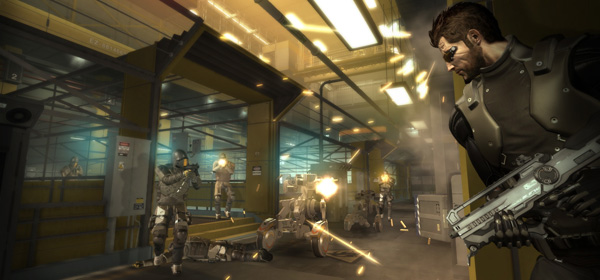
To say I’m a fan of the original Deus Ex is a bit of an understatement, and I must admit that my hopes and expectations of this prequel were mountainous. Dozens of trailers and gameplay previews teased me with what was clearly a beautifully designed game graphically, but I was dying to know if the story and gameplay would prove to be as deep and ambitious as its older brother. And now we find ourselves in the present. I have played through the entirety of Human Revolution, and I now know the answer…
Set 25 or so years before the events of the first game, this is the story of a civilisation on the brink of a great technological advancement. Nano augmentation hasn’t fully taken off yet, instead it’s a world full of very physical prosthetics, desirable for cosmetic reasons to those that can afford it, while the poor continue to live in squalor. You play as Adam Jensen: a security guard for Sarif Industries which is a leading corporation in the development of augmentations and prosthetics. After an attack on the company, Adam is left brutally injured and forced to undergo surgery that augments his entire body just to survive.
What this essentially means for us, as the player, is we get to control a superhuman badass with x-ray vision and razor sharp retractable elbow-swords. Yes, Adam Jensen is an awesome character to take control of, and he’s as versatile as you need him to be. You can play in almost any style you wish, and the game will cleverly adapt and react to your decisions – a concept which was heavily hyped up in the marketing as the game approached its final release, but one that thankfully does live up to its promise in the game proper. It’s a relief that a studio is willing to goto the effort of making a game with as much depth as this. Its been a long time since we’ve had a long FPS-RPG hybrid to sink our teeth into, and its the freedom of choice that separates this type of game from the regular mindless FPS currently saturating the market. You’ll always be presented with numerous routes during each and every mission, and its completely up to you if you want to go in guns blazing or take the quieter, less violent approach.
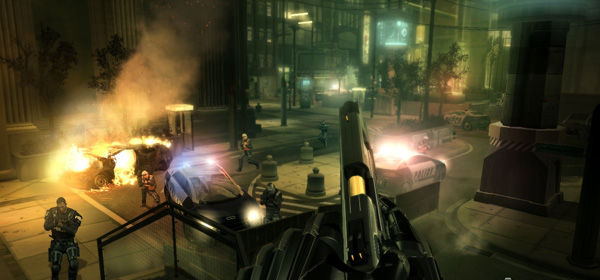
Despite having those choices, stealth is the preferred way to play, not only because of the peculiar design decision to reward more XP to the less aggressive player, but also because sneaking around feels so damn good. Touch the right-mouse button and you’ll slip smoothly into a third-person view while Jensen presses up against the nearest solid surface, giving you a wide clear view of your surroundings. You’ve likely seen a similar mechanic in games such as Gears of War, but here it feels more like Rainbow Six Vegas due to the majority of the game being spent in first-person. Once in cover, you can blind fire at enemies, lean over for an accurate shot, or dive across to an adjacent area quickly and easily. It feels great, and enhances the feeling that you’re in control of a guy who knows what he’s doing. I was concerned that the game was straying too far from its roots with additions like this, but my fears were laid to rest, and I will miss some of Jensen’s new skills if I ever get back to playing through the original Deus Ex again.
Tranquilizing foes from a distance is a hugely viable tactic, in that if you fire a dart in an enemy’s back, chances are they won’t even know until a few seconds later when they comically pass out and their face hits the floor. I opted for this approach in most situations, but because I wasn’t going for the pacifist achievement I wasn’t afraid to dish out some serious gunishment when my plans fell apart. Improvisation is your best friend. When a room full of guards spotted their mate keel over with a dart in his neck and all made a beeline for my hiding spot, I quickly punched through a nearby wall, grabbed a turret I had hacked to be on my side a few minutes earlier and positioned it facing the room’s new makeshift-doorway. Running the opposite direction, listening to gunfire and screams behind me, I made my escape down a side passage. Providing you can think on your feet, there’s always a solution to any sticky situation you find yourself in, and it is hugely satisfying.
Another new feature to the series are the takedowns. They come in two flavours – non-lethal, and elbow-swords. Jensen requires energy to use his various special moves (some of which are unlocked through the upgrade system – more of this in a minute) and providing you have one ‘battery’ of energy, you can perform one of these superbly animated takedowns. Get close to an enemy, and the icon will pop up – tap to perform a silent non-lethal takedown, or press and hold it to murder the poor target in a shockingly brutal execution. These moves feel nicely balanced, giving you a get-out-of-jail free card when things go awry, but can’t be relied on indefinitely due to the cost of energy cells. Use them all up, and you won’t be able to perform any more, nor any of Adam’s other special augmentations, depending on what you’ve unlocked.
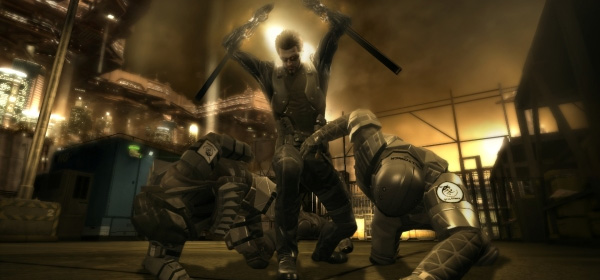
So, about those augmentations… Certain augs will be available to you from the offset – things like health regeneration and minimap are there by default, but as you earn XP through the game you’ll be able to unlock a whole bunch of new skills. It’s actually a spoiler to discuss them in too much detail, because one of the fun things is to discover these yourself. Suffice to say, you can upgrade various parts of your body and become stronger, faster, more agile, and so forth. The way it works is fairly elegant in that you spend 2 praxis points to get the first stage of a skill, but subsequent unlocks only cost 1 praxis point. Therfore, you find yourself pondering over which aug to unlock first, and whether its worth investing more to make it even better, or to spread your skills out across other areas. Everything is useful in some way, so it really comes down to which playstyle you’re adopting that will help you choose which augmentations to unlock.
If all of this sounds familiar, then you probably played Deus Ex back in the day. Most of what Human Revolution does well is an evolved form of what the first game tried all those years ago. The multi-route conversations, the hub city worlds, the upgrade system, even the large corporations vying for power in a slightly dystopian future reeks of pleasant nostalgia, and the game feels like a true prequel many of us were hoping for. You even have a personal helicopter pilot who takes you to your missions (amusingly, its a highly advanced VTOL flying machine – far more advanced than the rotor-bladed helicopter supposedly built 25 years later in the original game, but then according to Deus Ex we still all watch TV on a 4:3 resolution). The developers have said they had no choice but to make Human Revolution feel more futuristic because some of the technology seen in the first game has already been surpassed in the real world. It was a smart move if you ask me. This is one of the best game worlds I’ve explored all year and it captures a suitable mix of gritty realism with fantastical future.
The city hubs are the best example of this. You visit numerous countries across the course of the game, and at several points you’re given the freedom to explore a large, open hub world. They feel alive, there’s just so much detail to observe. NPC’s will have conversations with each other, and eavesdropping will often result in some useful information that’ll help you progress in some way. Sometimes you can initiate conversation with them and they’ll give you a side mission to carry out. Each of these optional quests are unique, well-acted set pieces with numerous solutions. They can be missed if you aren’t the sort who wanders around talking to everyone, and none of them are essential to the main plot, but they all help in fleshing out this fascinating world and I found myself meticulously completing every single one before moving the main story along.
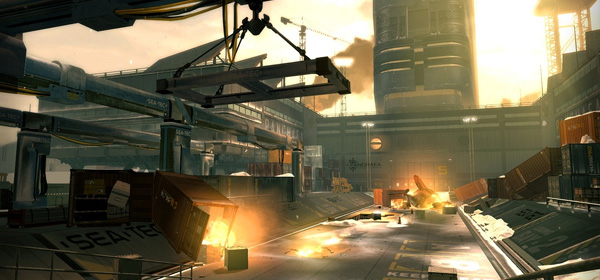
I don’t think the game is quite as clever as it thinks it is. Don’t get me wrong, there’s a lot of intelligent writing here, and its been a long time since I’ve played a game with so much hidden backstory and little details tucked away for those willing to look. But despite this, I felt very little reason to read all of the e-books that were strewn around because I simply didn’t find them very interesting. I did however, appreciate all of the news stories that appear on the TV’s throughout the game which change as the story progresses to reflect key plot points and other goings-on in the world that soon become relevant. Also, the option to be a nosey git and hack anyone’s computer you happen to come across (there are hundreds) is still a nice touch, but reading people’s emails often only reveals one of two things – a new access code to a nearby doorlock, or a throwaway bit of banter. Its less a complaint, and more an observation that by the time I got to the later stages of the game after hacking countless numbers of machines, I got a bit bored of the process and simply stopped doing it because I knew what to expect.
It would be impossible for me to tell you what I think of this game without mentioning the infamously controversial boss fights. There are only a few in the game, which is the silver lining in an otherwise dirty cloud, and they simply feel very out of place. While the game gives you the freedom to behave the way you want for every other situation, here you are left with only the option of a fight to the death. And my god are they tedious. Each fight takes place in a very traditional boss ‘arena’ style room, and all you can do is pump them full of bullets until they fall down and the next cutscene triggers. Its not only the fact your choice is made for you, but the way the bosses are presented is really lacking. There’s almost no build up or explanation for their existence in the game, so all the fights feel like little more than an irritant getting in the way of the actual story. That said, they can be over quickly once you figure out their weaknesses, and in any other game would be reasonably tolerable. Their presence here spoils an otherwise well-paced gameplay experience and makes them stick out like a sore thumb.
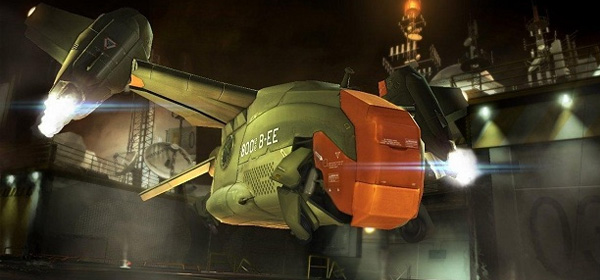
From a technical viewpoint, there’s very little to complain about. The game is built in a modified version of the Tomb Raider Underworld engine, which has proved to be more than capable of providing some gorgeous visuals. The star of the show is the art design, with each location full of intricate details and soft lighting. Character animations are adequate, but you will notice some repetition in a few of the NPC’s around the hub worlds. Key characters have more detail, understandably. The original Deus Ex featured some notoriously dodgy voice acting, but here things are much improved. I particularly enjoyed Adam Jensen’s gruff, raspy voice, but the majority of dialogue throughout the game is both well-written and well-acted.
Thankfully, Deus Ex: Human Revolution has proved to be an excellent game. Fans of the original should see this as the superior sequel, after the disappointing Invisible War which has now been thoroughly overshadowed. There are so many little nods to the original game that I found myself grinning from ear to ear at the mere mention of a recognisable name or organisation, and the few flaws it has stand out simply because so much care and attention has gone into the rest of the game. Regardless of what you think of those dumb boss fights, you should look at the bigger picture and enjoy what is a remarkable game, and one that I look forward to revisiting somewhere in the future to try out all the other possibilities that I missed on the first run through. It’s one of the best games of the year, and absolutely deserves your attention.
